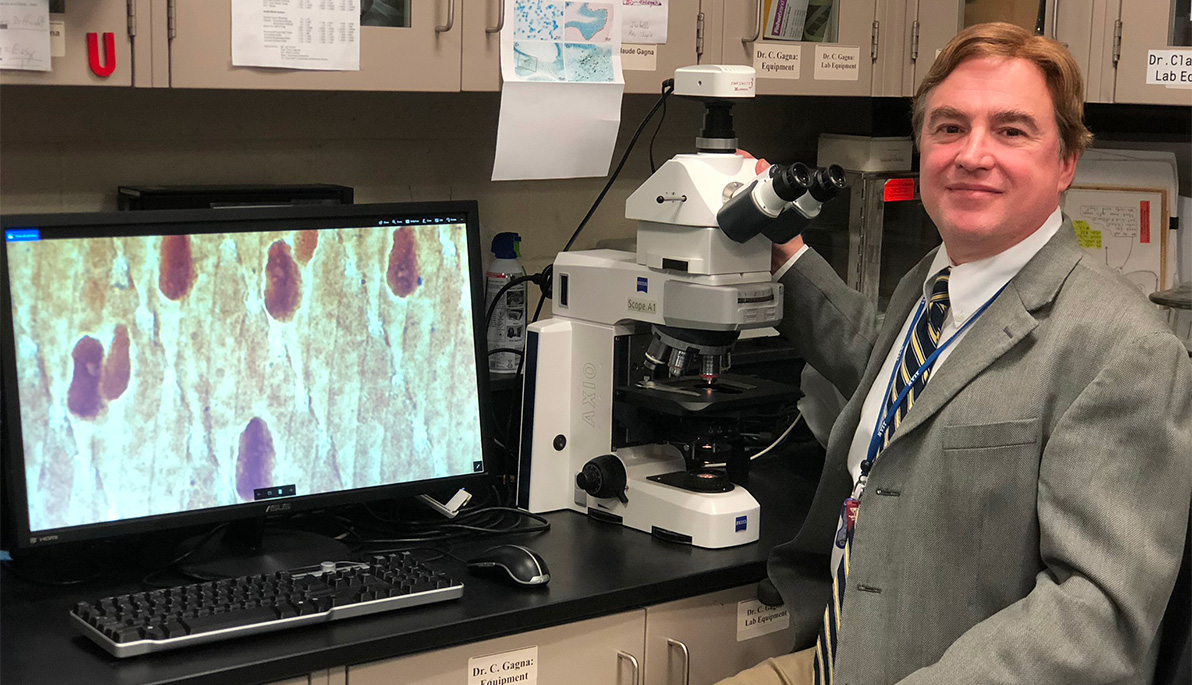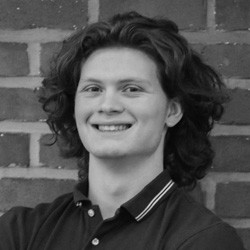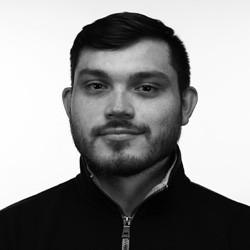Using DNA to Revolutionize Drug Research
Associate Professor of Life Sciences Claude Gagna, Ph.D., wears science like a pair of comfortable jeans. After decades studying the structure and function of canonical DNA and exotic DNA, it’s fair to say he is comfortable in the complex world of DNA conformations and gene expressions. Yes, he’s comfy in genes.
DNA Info
DNA comes in two types:
- Canonical DNA, which is also known as the “right-hand double-stranded B-DNA”
- Exotic DNA, including alternatives such as the “left-handed Z-DNA” and multi-stranded DNA types, such as four-stranded DNA.
Microarrays: the Old and the New
- Conventional microarray slides immobilize thousands of single DNA strands, enabling scientists to look at gene expression on a microscopic level.
- Next generation DNA and RNA microarrays can immobilize single strands as well as intact, naturally occurring DNA segments—which could lead to advances in gene manipulation and DNA-based drug research.
How comfortable? Enough that Gagna, who earned a Ph.D. in basic medical sciences from New York University and a master’s in human anatomy from Farleigh Dickenson University, believes he’s one federal grant away from a game-changing advance in DNA-based drug discovery.
Like all DNA/RNA researchers, Gagna—who joined NYIT in 1999 and is a frequent collaborator with researchers at Rutgers-New Jersey Medical School, Albert Einstein College of Medicine, and other university faculty—often employs microarrays in his lab work. The conventional 1”x3” glass microarray slides immobilize thousands of single DNA strands, giving scientists a microscopic look at gene expression—in other words, the thing that makes genes tick.
In a lightbulb moment more than a decade ago, Gagna realized science was missing out on conventional DNA microarrays, which compared single DNA strands representing different genes, but didn’t give scientists a look at whole DNA structures.
In 2005, Gagna and NYIT earned a U.S. and Japanese patent for the “next generation” of DNA and RNA microarrays—including the ability to immobilize not only single strands, but also intact, naturally occurring DNA segments, a potential blockbuster for pharmaceutical interests and other researchers.
“This immobilizes the DNA, unaltered, exactly how it exists within a cell,” Gagna says. “Now you have an entire intact segment of DNA, and you can perform all sorts of highly controlled experiments within different environments.”
Those experiments have the potential for studying whole segments of exotic DNA. According to Gagna, by studying entire or partial gene segments of double-, triple-, or even quadruple-stranded DNA, scientists could unlock advances in gene manipulation and other 21st century sciences. “This would really be helpful in terms of drug discovery and development,” he says. “Experiments with drugs that bind to DNA could lead to pharmaceutical products that, in effect, shut down a pathological gene expression—in other words, they could ‘turn off’ the bad genes.”
Gagna’s science, which comes as close as possible to recreating the environmental conditions within cells, is sound: He’s already formed a working partnership with Silicon Valley-based manufacturer Arrayit Corp., which has already produced working prototypes.
Gagna is also considering applying for a U.S. Small Business Administration Small Business Technology Transfer (STTR) grant, likely in the $1.5–3 million range. That would be enough funding, he says, to launch a small startup that could market and manufacture the next-gen microarrays.
“If you’re a pharmaceutical company with 50 new chemicals or biologics, you might want to test them out with our microarrays to see if they’re binding with B-DNA, Z-DNA or quadruplex DNA,” he says. “If they are, maybe you can use those new drugs to inhibit gene expression of a disease, and you have your billion-dollar drug.
“This is a cutting-edge approach that can save pharmaceutical companies a lot of time and money, which might result in lower drug prices.”
Arrayit Corp., an 800-pound gorilla in the world of microarrays, is on board and would be part of the STTR grant, bringing its high-end manufacturing, software, and marketing expertise into a potential corporate mix.
“The basic research would be done here at NYIT with our students and the large-scale manufacturing would be done by Arrayit,” Gagna notes. “They believe in the product. They want to be part of the grant. They want to be part of the team.”
Gagna is currently formulating a strategy with NYIT administrators on how to proceed. He estimates a best-case scenario of roughly six years to perfect prototypes and of venture capitalization in order to deliver a fully commercialized product with global potential.
“We already have Arrayit Corp, which knows how to sell microarrays, so we don’t have to go out and hire a sales team,” Gagna says. “And we’re offering researchers two important things: a new approach to studying the structure and function of canonical and exotic DNA and RNA, and a chance to enhance drug-discovery.”
All this will take time, he notes. “We’re also going to have to develop new instrumentation to fabricate the novel microarrays and software to read the results. But when we do, it could be revolutionary.”
Read more about Gagna.











